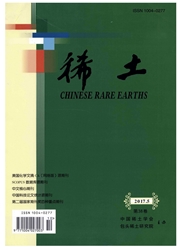

 中文摘要:
中文摘要:
采用液相离子交换法制备了不同铈含量的Y型分子筛(HY、USY和Na Y),研究了经高温焙烧后铈离子(铈)迁移对Y型分子筛活性中心的影响,并用X-射线粉末衍射(XRD)、原位傅里叶变换红外光谱技术(in situ FTIR)以及氨气程序升温脱附(NH3-TPD)等多种表征手段对稀土Y分子筛内铈离子的相对迁移量、结晶保留率以及酸强度分布等进行了分析。结果表明,铈离子向小笼的相对迁移量对分子筛酸强度分布的调变作用并未产生直接影响,而具有一定特点的晶型结构的保留能力是酸强度分布变化的主要原因,尤其在高温复杂苛刻条件下,稀土Y分子筛(铈Y)的催化活性主要来源于含有强L酸稀土铈物种的方钠石笼结构以及部分的B酸。
 英文摘要:
英文摘要:
Different types of Y zeolite (HY, USY and NaY) containing various amounts of rare earth (Cerium) were pre- pared with the method of liquid ion exchange. The effects of cerium ions migration on active sites of Y zeolite was investigated. The prepared samples were characterized by X- ray diffraction (XRD), infrared spectrum (in situ FTIR IR) and NH3 tempera- ture -programmed desorption (NH3 -TPD). The results show that the relative amount of ions which migrate into the sodalite cage has no direct effect obviously on the distribution of acid strength. However, crystallinity - retained capacity is the key influ- ence factor of it. Under the high temperature and hydrothermal conditions, catalytic activity of modified Y zeolites by cerium mainly comes from the crystalline structure of sodalite cage with stronger Lewis - acid species and partial Brcpnsted - acid.
 同期刊论文项目
同期刊论文项目
 同项目期刊论文
同项目期刊论文
 期刊信息
期刊信息
